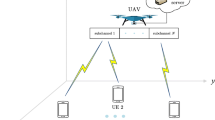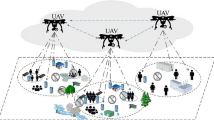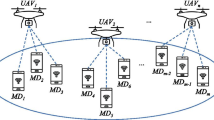Abstract
To address the challenges in the era of artificial intelligence, this paper investigates how computing offloading techniques can be utilized to improve the system performance in cellular connected unmanned aerial vehicle (UAV) networks with limited resources using non-orthogonal multiple access (NOMA) and mobile edge computing techniques. Energy consumed by the UAV in performing tasks and the time required to complete tasks are minimized by joint optimal task offloading decision, sub-channel allocation, and computing resource allocation while satisfying the user's quality of service requirements. We consider this problem as a nonlinear programming problem with integer and non-integer variables and solve it by iteratively updating the resource allocation and offloading decision. Specifically, given a fixed offloading decision, a many-to-one matching model is first applied for sub-channel allocation, then a detailed allocation of computing resource is performed by optimizing the total system overhead, and are solved by utilizing the matching algorithm and the Lagrange dual method, respectively. Then, according to the scenarios we have been given for resource allocation, we design a multi-objective task offloading algorithm to update the offloading decision. Simulation experiments demonstrate the feasibility of the scheme, which shows a significant reduction in both energy consumption and latency compared to the benchmark scheme.












Similar content being viewed by others
Availability of Data and Materials
We are willing to share our code and additional material with interested readers upon reasonable request.
References
Yang, Y., Karimadini, M., Xiang, C., Teo, S. H., Chen, B. M. & Lee, T. H. (2015). Wide area surveillance of urban environments using multiple Mini-VTOL UAVs. In IECON 2015 - 41st Annual Conference of the IEEE Industrial Electronics Society, Yokohama, Japan, 2015, pp. 000795–000800. https://doi.org/10.1109/IECON.2015.7392196.
Xiao, P., Wang, L., Chuan, J., Wang, X., Kuang, J., & Fei, A. (2019) Implementation for UAVs aided edge sensing system in wireless emergency communications. In 2019 11th international conference on wireless communications and signal processing (WCSP), Xi'an, China, 2019, pp. 1–5, https://doi.org/10.1109/WCSP.2019.8927886.
Katsigiannis, P., Misopolinos, L.. Liakopoulos, V., Alexandridis, T. K. & Zalidis, G. (2016). An autonomous multi-sensor UAV system for reduced-input precision agriculture applications. In 2016 24th mediterranean conference on control and automation (MED), Athens, Greece (pp. 60–64). https://doi.org/10.1109/MED.2016.7535938.
Zeng, Y., Zhang, R., & Lim, T. J. (2016). Wireless communications with unmanned aerial vehicles: Opportunities and challenges. IEEE Communications Magazine, 54(5), 36–42. https://doi.org/10.1109/MCOM.2016.7470933
Zeng, Y., Lyu, J., & Zhang, R. (2019). Cellular-connected UAV: Potential, challenges, and promising technologies. IEEE Wireless Communications, 26(1), 120–127. https://doi.org/10.1109/MWC.2018.1800023
Amer, R., Saad, W., & Marchetti, N. (2020). Mobility in the sky: Performance and mobility analysis for cellular-connected UAVs. IEEE Transactions on Communications, 68(5), 3229–3246. https://doi.org/10.1109/TCOMM.2020.2973629
Azari, M. M., Rosas, F., & Pollin, S. (2019). Cellular connectivity for UAVs: Network modeling, performance analysis, and design guidelines. IEEE Transactions on Wireless Communications, 18(7), 3366–3381. https://doi.org/10.1109/TWC.2019.2910112
Pang, X., et al. (2020). Uplink precoding optimization for NOMA cellular-connected UAV networks. IEEE Transactions on Communications, 68(2), 1271–1283. https://doi.org/10.1109/TCOMM.2019.2954136
Muruganathan, S. D., et al. (2021). An overview of 3GPP release-15 study on enhanced LTE support for connected drones. IEEE Communications Standards Magazine, 5(4), 140–146. https://doi.org/10.1109/MCOMSTD.0001.1900021
Van Der Bergh, B., Chiumento, A., & Pollin, S. (2016). LTE in the sky: Trading off propagation benefits with interference costs for aerial nodes. IEEE Communications Magazine, 54(5), 44–50. https://doi.org/10.1109/MCOM.2016.7470934
Songlei, Z., Sheng, W., & Xiaoqian, C. (2018). A brief discussion on UAV emergency communication technology based on LTE. China Strategic Emerging Industries, 16, 143. https://doi.org/10.19474/j.cnki.10-1156/f.004491
Hua, M., Huang, Y., Sun, Y., Wang, Y. & Yang, L. (2018). Energy optimization for cellular-connected UAV mobile edge computing systems. In 2018 IEEE international conference on communication systems (ICCS), Chengdu, China (pp. 1–6) https://doi.org/10.1109/ICCS.2018.8689226.
Hua, M., Huang, Y., Wang, Y., Wu, Q., Dai, H., & Yang, L. (2018). Energy optimization for cellular-connected multi-UAV mobile edge computing systems with multi-access schemes. Journal of Communications and Information Networks, 3(4), 33–44. https://doi.org/10.1007/s41650-018-0035-0
Messous, M. -A., Sedjelmaci, H., Houari, N. & Senouci, S. -M. (2017) Computation offloading game for an UAV network in mobile edge computing. In 2017 IEEE international conference on communications (ICC), Paris, France (pp. 1–6). https://doi.org/10.1109/ICC.2017.7996483.
Weiping, P., Mingkun, W., Cheng, S., & Zongpu, J. (2021). Adaptive task offloading decision of multi-UAVs cooperation in live broadcasting scenario[J]. Control and Decision, 36(04), 974–982.
Cao, X., Xu, J. & Zhang, R. (2018). Mobile edge computing for cellular-connected UAV: Computation offloading and trajectory optimization. In 2018 IEEE 19th international workshop on signal processing advances in wireless communications (SPAWC), Kalamata, Greece (pp. 1–5). https://doi.org/10.1109/SPAWC.2018.8445936
Kim, K. & Hong, C.S. (2019). Optimal task-UAV-edge matching for computation offloading in uav assisted mobile edge computing. In 2019 20th Asia-Pacific network operations and management symposium (APNOMS), Matsue, Japan, 2019, pp. 1–4. https://doi.org/10.23919/APNOMS.2019.8892864
Zhang, Q., Chen, J., Ji, L., Feng, Z., Han, Z., & Chen, Z. (2020). Response delay optimization in mobile edge computing enabled UAV swarm. IEEE Transactions on Vehicular Technology, 69(3), 3280–3295. https://doi.org/10.1109/TVT.2020.2964821
Kim, K., Park, Y. M., & Seon Hong, C. (2020). Machine learning based edge-assisted UAV computation offloading for data analyzing. In 2020 International conference on information networking (ICOIN), Barcelona, Spain, pp. 117–120. https://doi.org/10.1109/ICOIN48656.2020.9016432.
Mitsis, G., Tsiropoulou, E. E., & Papavassiliou, S. (2022). Price and risk awareness for data offloading decision-making in edge computing systems. IEEE Systems Journal, 16(4), 6546–6557. https://doi.org/10.1109/JSYST.2022.3188997
Popovski, P., et al. (2018). Wireless access for ultra-reliable low-latency communication: principles and building blocks. IEEE Network, 32(2), 16–23. https://doi.org/10.1109/MNET.2018.1700258
Boshkovska, E., Ng, D. W. K., Zlatanov, N., Koelpin, A., & Schober, R. (2017). Robust resource allocation for MIMO wireless powered communication networks based on a non-linear EH model. IEEE Transactions on Communications, 65(5), 1984–1999. https://doi.org/10.1109/TCOMM.2017.2664860
Pan, Y., Chen, M., Yang, Z., Huang, N., & Shikh-Bahaei, M. (2019). Energy-efficient NOMA-based mobile edge computing offloading. IEEE Communications Letters, 23(2), 310–313. https://doi.org/10.1109/LCOMM.2018.2882846
Mao, Y., You, C., Zhang, J., Huang, K., & Letaief, K. B. (2017). A survey on mobile edge computing: the communication perspective. IEEE Communications Surveys & Tutorials, 19(4), 2322–2358. https://doi.org/10.1109/COMST.2017.2745201
Alnoman, A., Erkucuk, S., & Anpalagan, A. (2019). Sparse code multiple access-based edge computing for IoT systems. IEEE Internet of Things Journal, 6(4), 7152–7161. https://doi.org/10.1109/JIOT.2019.2914570
Wang, F., Ren, M., Yang, L., He, B., & Zhou, Y. (2023). Latency optimization of task offloading in NOMA-MEC systems. IET Communications, 17(5), 591–602.
Li, G., Zeng, M., Mishra, D., Hao, L., Ma, Z., & Dobre, O. A. (2023). Latency minimization for IRS-aided NOMA MEC systems with WPT-enabled IoT devices. IEEE Internet of Things Journal, 10(14), 12156–12168. https://doi.org/10.1109/JIOT.2023.3240395
Ding, Z., Xu, D., Schober, R., & Poor, H. V. (2022). Hybrid NOMA offloading in multi-user MEC networks. IEEE Transactions on Wireless Communications, 21(7), 5377–5391. https://doi.org/10.1109/TWC.2021.3139932
Liu, Z., Qi, J., Shen, Y., Ma, K., & Guan, X. (2023). Maximizing energy efficiency in UAV-assisted NOMA-MEC networks. IEEE Internet of Things Journal. https://doi.org/10.1109/JIOT.2023.3303491
Liu, S., Huang, Y., Hu, H., Si, J., Kang, Q., Pan, Y., & Gu, C. (2023). "Minimizing energy consumption in UAV assisted NOMA-MEC networks. Physical Communication, 60, 102167.
Al-Hourani, A., Kandeepan, S., & Lardner, S. (2014). Optimal LAP altitude for maximum coverage. IEEE Wireless Communications Letters, 3(6), 569–572. https://doi.org/10.1109/LWC.2014.2342736
Khuwaja, A. A., Chen, Y., Zhao, N., Alouini, M. -S. & Dobbins, P. (2018). A survey of channel modeling for UAV communications. In IEEE Communications Surveys & Tutorials (vol. 20, no. 4, pp. 2804–2821). Fourthquarter. https://doi.org/10.1109/COMST.2018.2856587.
Azam, I., Shahab, M. B., & Shin, S. Y. (2022). Energy-efficient pairing and power allocation for NOMA UAV network under QoS constraints. IEEE Internet of Things Journal, 9(24), 25011–25026. https://doi.org/10.1109/JIOT.2022.3195197
Zeng, Y., Xu, J., & Zhang, R. (2019). Energy minimization for wireless communication with rotary-wing UAV. IEEE Transactions on Wireless Communications, 18(4), 2329–2345. https://doi.org/10.1109/TWC.2019.2902559
Gu, Y., Saad, W., Bennis, M., Debbah, M., & Han, Z. (2015). Matching theory for future wireless networks: Fundamentals and applications. IEEE Communications Magazine, 53(5), 52–59. https://doi.org/10.1109/MCOM.2015.7105641
Funding
Science and Technology Program of Gansu Province, 23YFGA0062 Supported by Innovation Foundation of Gansu Province, 2022A-215.
Author information
Authors and Affiliations
Contributions
JX: Supervision. YM: Conceptualization, Methodology, Data curation, Writing-original draft, Writing-review and editing. GT: Validation. Jun Dou: Validation. XG: Supervision.
Corresponding author
Ethics declarations
Conflict of interest
I declare that the authors have no competing interests as defined by Springer, or other interests that might be perceived to influence the results and discussion reported in this paper.
Additional information
Publisher's Note
Springer Nature remains neutral with regard to jurisdictional claims in published maps and institutional affiliations.
Rights and permissions
Springer Nature or its licensor (e.g. a society or other partner) holds exclusive rights to this article under a publishing agreement with the author(s) or other rightsholder(s); author self-archiving of the accepted manuscript version of this article is solely governed by the terms of such publishing agreement and applicable law.
About this article
Cite this article
Xue, J., Ma, Y., Tian, G. et al. Resource Allocation and Offloading Decision of UAV Based on NOMA-MEC. Wireless Pers Commun 133, 259–288 (2023). https://doi.org/10.1007/s11277-023-10767-9
Accepted:
Published:
Issue Date:
DOI: https://doi.org/10.1007/s11277-023-10767-9




